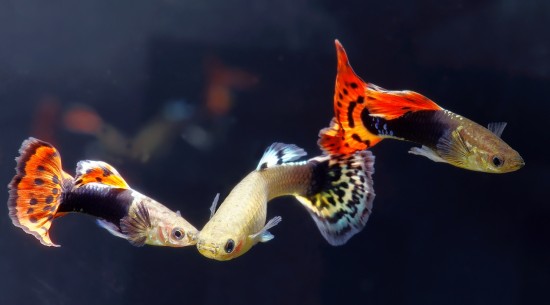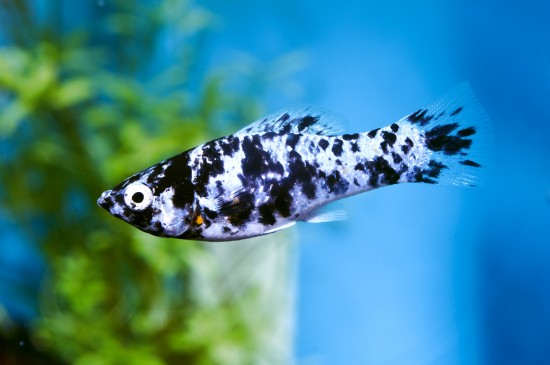


What’s not to love about a brightly coloured fish, that is small enough to fit in any reasonable tank, and peaceful enough not to be a threat to other fish. Originally found in the northern part of South America and Central America, Mollies and guppies are now found across most of the world.
Native to: Antigua and Barbuda, Barbados, Brazil, Guyana, Jamaica, the Netherlands Antilles, Trinidad and Tobago, U.S. Virgin Islands and Venezuela.
Typical Lifespan in the wild: 2 years
Reproduction: Guppies are livebearers, meaning the young are born fully able to function and swim away. Unlike mammals the young don’t get nourishment from the mother, instead they grow in an egg feeding from a yolk, the only difference being the egg is retained by the mother till the egg hatches. This is probably a step in the evolution of a placenta and a true pregnancy, which is seen in other members of the same family.
Females can reproduce between 10-20 weeks of age, and males are sexually mature at as young as 7 weeks. This means that in the wild there can be two or three generations per year. This can also happen in your tank, which means buying one female from the shop (who is likely to already be carrying fertilised eggs, for up to 8 months ahead) can turn into hundreds of fish in a relatively short space of time as she gives birth, and they in turn mate and give birth.
In the wild the number of predators will determine the type of males that the female chooses, she will pick the duller males if there are a lot of predators and brighter males if she feels safer, the number of young she gives birth to, she will have a higher number of small fry if there are a lot of predators. She will also have a larger brood size if there is a lot of food available.
Behaviour: Guppies may seem like graceful little additions to your tank, but looks can fool, they have bags of personality. In the wild they shoal in groups of up to 200 individuals. When they see a predator they will inspect the predator to see how much of a threat it is. This obviously puts them in danger, so they avoid the mouth area. They take turns taking the risk of predator inspection, and if an individual doesn’t take their fair share of the risks the others will hang back and force them to move forward.
One thing to look out for is the fact the males will harass the females, in the wild and in huge shoals this behaviour is spread out, but in the tank with one male per female this can prove to be too much for the female.
Health: 10 years ago guppies were the by word for strong and healthy. They’d take just about anything that even the newest fish keeper could throw at them and carry on breeding. Now even experienced keepers can struggle with these as they can be fragile. Buy from a good source and consider buying from a breeder rather than a local fish shop. Make sure your tank is well established before adding guppies.
Tank set up: Most tanks and tank sizes are suitable, guppies prefer moderately hard and moderately alkaline waters, although tank bred varieties have adapted to most water conditions.
Avoid aggressive or fin nipping tank mates, the long fins of the male guppies seem to be irresistible to many tetras and barbs, also be aware that they can hybridise with endlers and mollies, so try and keep them as the only live bearer species. Keep at least 2 females to every male, or just have a group of males alone.
Having a heavily planted tank will allow the fry a place to hide, and well fed adult guppies tend not to eat their own fry, although the same can’t be said for other tank mates.
Also Live bearers Mollies could be the perfect aquarium fish, they are slightly larger, up to 10 cm in some cases, but most are in the 6-7 cm region, also available in a wide variety of colours they lack the following fins that are prone to being nipped by other fish. The females are tough enough to withstand persistent males, and being closer in shape and colour to the wild variety means that new blood is reintroduced on occasion, keeping the captive population strong and healthy, maturity is delayed in comparison to guppies, with some species not being sexually mature until they are a year old They are almost perfect except for one small issue. Of the family Poecilia every species except Guppies and Endlers are known by the common name Molly. This leads to not only a wide variety of fish (38 species) going under the catch all term, but also a wide variety of tank requirements. A few examples include…
Poecilia velifera Yucatan Molly: native to the coast of the Yucatan peninsula. These require brackish water and slightly lower temperatures of 25-28°C. Similar looking to the sailfin molly they are often confused.
Poecilia latipinna Sailfin Molly: Unusually this species is found in fresh, brackish and salt water environments. Naturally a silver grey colour, in the aquarium there are a variety of colours. These are a commonly available species of Molly, but frequently have been hybridised with other molly species. Their up turned mouth means that they can make use of the oxygen rich water at the surface of the water. Their natural diet is high in vegetable and algae matter. Whilst some people will claim that Sailfin Mollies can be kept in cold water they are a tropical, although hardy species, aim for mid to high 20s C to keep them healthy.
The Black molly is a hybrid of the P. latipinna and the Common Molly (P. sphenops)
The difficulty in knowing exactly what fish you have means that you can never be sure if they need fresh, salt or brackish water, but in general if you keep the water stable and tend towards the moderately hard end of the scale then they’ll do fine. If your water is soft and acidic watch out for skin infections and fungal disease.
Live bearers are a great fish to keep, both as a beginner getting into the hobby, or as an experienced keeper looking for more usual species, guppies are widely shown in competitions, there are also numerous rare species of Molly and unusual colours of Guppies, looking for a real challenge, The Sulphur molly (Poecilia sulphuraria) has adapted to live in high sulphur springs, which is toxic to all other species of fish, Critically endangered in the wild if you can source a breeding pair you would be helping save a species assuming you can work out how to keep them alive in an aquarium setting.
It’s always worth keeping live bearing species separate to reduce the risk of hybridisation, source your fish from reputable importers or breeders to have healthy and long lived fish.
 Why Do Dogs..? Part One
Why Do Dogs..? Pa
Why Do Dogs..? Part One
Why Do Dogs..? Pa
 Neutering Your New Cat Or Kitten
Neutering Your Ne
Neutering Your New Cat Or Kitten
Neutering Your Ne
 Impetigo In Puppies
Impetigo In Puppi
Impetigo In Puppies
Impetigo In Puppi
 The process of moving to Singapore with dogs- what you need to know
The process of moving to Singapore with dogs- what you nee
The process of moving to Singapore with dogs- what you need to know
The process of moving to Singapore with dogs- what you nee
 How Does Spaying And Neutering Affect Dogs?
How Does Spaying
How Does Spaying And Neutering Affect Dogs?
How Does Spaying
Copyright © 2005-2016 Pet Information All Rights Reserved
Contact us: www162date@outlook.com